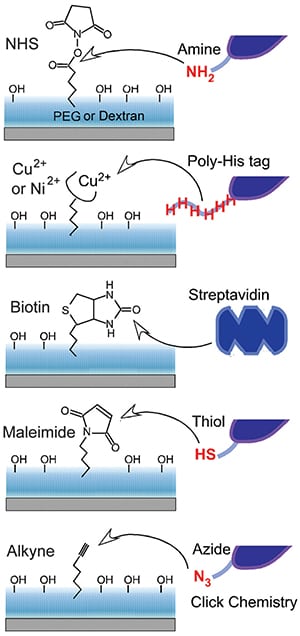 We have successfully developed a proprietary technology which allows us to coat glass, silicon wafer, quartz, & other substrates with a robust, high density layer of poly-ethyleneglycol (PEG) or Dextran brush. The density of PEG or Dextran functionality on the surface is orders of magnitude higher than those from the conventional silane coupling chemistry. The PEG or Dextran coating is intrinsically inert towards the adsorption of proteins, cells and other biomolecules, thus providing a zero-background starting surface in a variety of biomedical experiments. We have also developed various surface conjugation chemistry to allow user to immobilize a wide variety of biomolecues on the otherwise zero background PEG or Dextran brush. Available funcitonalities include -NHS leaving groups for covalent attachment to -NH2 functional group, biotin for conjugation with the biotin/avidin chemistry, chelated metal ions for binding to poly-histidine tags, alkyne for specific interaction with azide (i.e., Click Chemistry), and maleimide for linking to -SH groups.
We have successfully developed a proprietary technology which allows us to coat glass, silicon wafer, quartz, & other substrates with a robust, high density layer of poly-ethyleneglycol (PEG) or Dextran brush. The density of PEG or Dextran functionality on the surface is orders of magnitude higher than those from the conventional silane coupling chemistry. The PEG or Dextran coating is intrinsically inert towards the adsorption of proteins, cells and other biomolecules, thus providing a zero-background starting surface in a variety of biomedical experiments. We have also developed various surface conjugation chemistry to allow user to immobilize a wide variety of biomolecues on the otherwise zero background PEG or Dextran brush. Available funcitonalities include -NHS leaving groups for covalent attachment to -NH2 functional group, biotin for conjugation with the biotin/avidin chemistry, chelated metal ions for binding to poly-histidine tags, alkyne for specific interaction with azide (i.e., Click Chemistry), and maleimide for linking to -SH groups.
These coatings are available on standard microscope slides, coverslips, silicon wafers. We also provide customer coating service for specific customer samples. Our customers have successfully applied these PEG surfaces for a range of applications, including protein sensors, protein microarrays, single molecule spectroscopy, biological atomic force microscopy and other biophysical studies.
Copy Right© 2015 Athena Guo. All rights reserved.